Arts & Entertainment Community
Gig Harbor Now and Then | Grave matters of life, death and debt
In our previous column we began the tale of death and burial on the early Peninsula with the stories of homesteaders Joseph Oakes of Rosedale and John Giblin of Gig Harbor. We will conclude this topic with an almost-homesteader, John Farrague, also of Gig Harbor. He filed a homestead claim, and it was eventually granted, but not until several years after his death. It played a major part in his estate just the same, however.
Farrague was one of the earliest settlers in Gig Harbor, being one of Samuel Jeresich’s business and investment partners.
But before we conclude the topic with John Farrague’s story, there are a few corrections to be made concerning John Giblin.
Not lost after all
In spite of John Giblin not being on the burial list of the Gig Harbor Cemetery, he has not been entirely lost, as I mistakenly concluded in the previous Gig Harbor Now and Then column. A very thoughtful reader came to the Harbor History Museum on the Wednesday following the publication of the column, and informed me of Giblin’s location. I visited the site within the hour. As I had speculated, his grave has been overtaken by a second-growth forest. His marker has not toppled over and has not been swallowed into the topsoil, however. This is it:
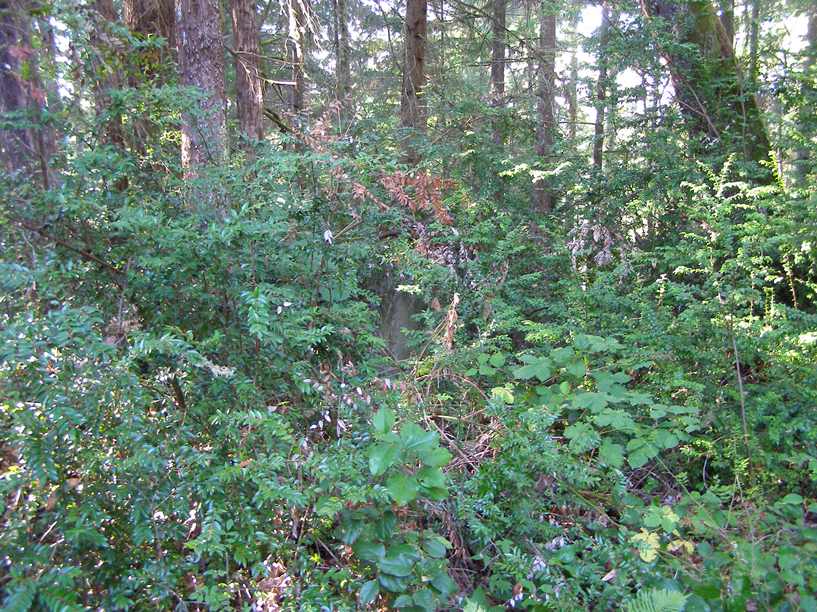
There it is. It’s not lost at all, as long as you get within about 20 feet of it. Photo by Greg Spadoni.
Pretty cool, huh?
This is what it looks like when approaching from a different side:
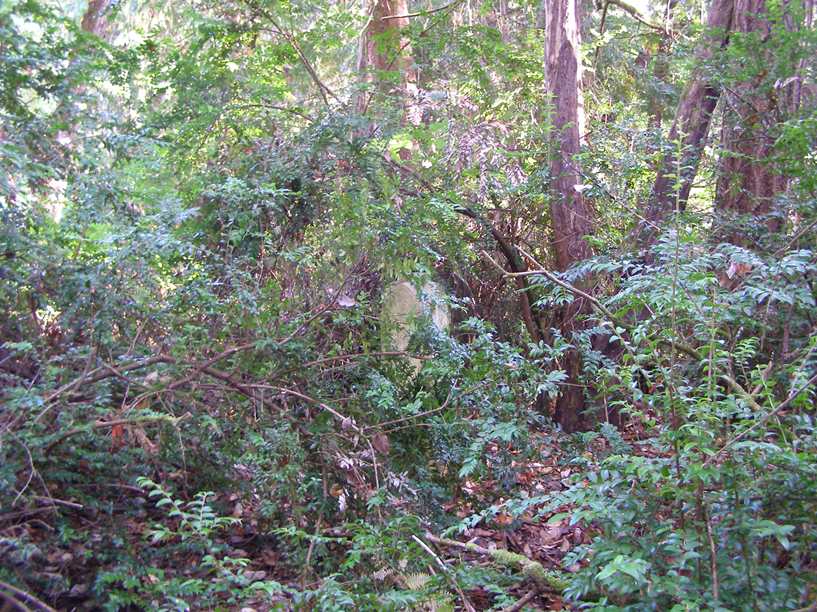
Close up, it looks every bit as impressive as you’d expect a $75 headstone from 1892 to be. And it’s holding up very well.
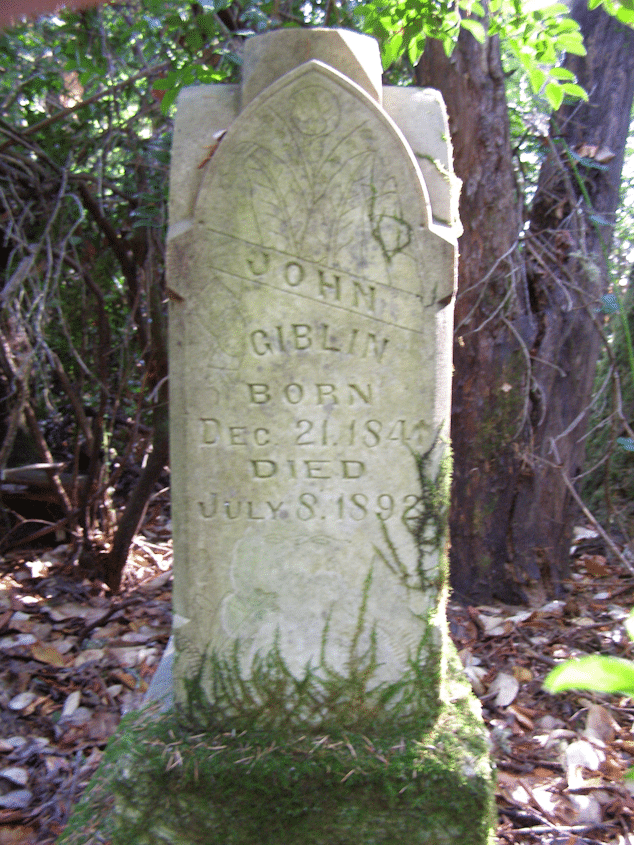
John Giblin’s $75 headstone is holding up better than this crummy picture shows. The sun was in my eyes, I swear! You can see in the upper left corner that I was shading the lens with my left hand. I could’ve cropped it out, but left it for corroborating evidence. Photo by Greg Spadoni.
Because Giblin’s marker was purchased from a marble and granite dealer in Tacoma, I had made the comment, “it was not noted in Giblin’s probate file whether the monument was marble or granite.” It turns out that it’s neither. I’m not sure what it’s made of, but my guess is sandstone.
My estimation of Giblin’s age was also faulty. I wasn’t certain because of conflicting information on state and county censuses, so I said he was somewhere between 38 and 46 years old. The age of 46 was from a census conducted three months before his death. It was wrong. He was 50 when the census was taken, and when he died.
A final note on John Giblin
Even though John Giblin’s headstone is not lost, the mystery surrounding it is not solved. Here’s the current twist: He’s not on the Gig Harbor Cemetery burial list because he’s not in the Gig Harbor Cemetery.
After reviewing deeds and studying maps, it looks like the Gig Harbor Cemetery Association sold the Giblin estate a piece of land it did not own. I strongly suspect I know how the mistake happened, but cannot prove it conclusively.
I spoke with the property owners where the headstone stands, and while they generously allowed me to see and photograph the marker, they asked me not to reveal its location.
Now, back to Death and Burial on the Early Peninsula, Part 2, featuring John Farrague. We begin with a familiar confusion.
Spellings of names
The spellings of Sam Jeresich and John Farrague’s last names alternated frequently throughout their lives. Jeresich and Farrague were considered to be the correct spellings in their time by some people, but other spellings were just as often used by others, Jerisich and Farragut being the most common alternatives.
Samuel Jeresich signed an affidavit (with his mark; he was illiterate) dated March 14, 1903, that said, in part, “… John Farragut is the same person who was commonly called John Farrague, and affiant [Jeresich] believes that the proper spelling of his name was Farrague and not Farragut.”
It appears that in spite of Jeresich’s belief, the proper spelling in Farrague’s home country of Spain did indeed include a t at the end. However, Farrague’s brother’s name is spelled two different ways in the probate file, with the letter e replacing one, and sometimes two, a’s: Ferragut and Ferregut.
As for his own name, Jeresich stated in the affidavit that in all his time in Gig Harbor, his name had “been pronounced by English speaking people, Samuel Jeresich, and affiant has always considered and now does consider that such is his true name.”
This column will use the various spellings as they were used in the recorded documents referenced, and otherwise use the spellings stated in Jeresich’s affidavit.
1895: John Farrague
John Farrague and Samuel Jeresich were among the first few white settlers in Gig Harbor, arriving about 1868. They filed side-by-side homesteads on the west side of the bay, jointly owned other land at the north end of the harbor and in Tacoma, and were partners in a fishing business.
In late 1895, knowing he was soon going to die, Farrague summoned long-time friend and current Justice of the Peace James S. Cole to his house to write down his last will and testament. Written in cursive on simple, lined paper, it reads,
State of Washington County of Pierce
Gig Harbor October. 14. 1895
The last will and Testament of John Farragut to Jose Ferragut I bequeath all my real and personal property to wit Lots No Three (3) and Four (4) in Block No One (1) and the undivided one half of Lots No One (1) and Two (2) in Block No (3) all in the Smelter Addition to Tacoma Washington as shown by the official plat now on file and of record in the Auditors office of said Pierce County Washington.
21 acres more or less of the undivided one half of 21 acres more or less of land being N. & NE of land now owned by A.M. Burnham Also one note And Mortgage of one Thousand Dollars against John Novauk and Josephine Novauk his wife. This will to be in full force after my death
And to my Nephew John Farragut I give my Gold watch And Chain and one gold locket
John his X mark Ferragut
Witness
Jas. S. Cole
Ricardo Corbella
Signed and witnessed before
me this 14th Day of October 1895
Jas. S. Cole Justice of the Peace
For the State of Washington
County of Pierce
Effectively, he was leaving everything to his brother, Jose (later in the proceedings known as Joseph). But he had one more potential asset that was not mentioned in his will. Cole advised Farrague to address it in a separate document, which he also wrote on the same day.
The codicil to his will bequeathed his last potential asset to three of Sam Jeresich’s children, Melissa (16), Catherine (14), and Julia (12). He likely would not have, if not for certain aspects of federal law.
As foreigners who were not intending to become citizens of the U.S., Farrague’s brother and nephew were not eligible to inherit his homestead claim. He therefore willed that part of his estate to the Jeresich girls, whom he had known all their lives in Gig Harbor. At the time of his death the land claim was in dispute, and would not be settled in his favor for several more years. (In an unfortunate twist, by the time the homestead claim was finally settled and awarded to his three non-relative heirs, two of the girls were dead, and did not benefit from it. Their heirs did, however.)
The codicil was simple and direct:
I John Farragut sign over all my right and interest in the claim where I now live to Melissa, Catheran and Julia Jerisich when I am through with it.
He was through with it on Nov. 13, 1895.
Administering the estate
Like John Giblin, because John Farrague had no relatives in Washington when he died, his estate was handled by friends and appointees. His good friend, close neighbor, and business partner Sam Jeresich was the most likely candidate for administrator of his estate. But in a petition to the probate court filed by Jeresich’s son John, asking that he be appointed executor instead of his father, is the statement, “Samuel Jerisich, the partner of the said John Farrague was and is an old man and is sick and unable to attend to the settlement of the said estate and requests that this petitioner be appointed.”
Ricardo Corbella, originally from Andujar, Spain, also petitioned the court to become the administrator. In his application, he claimed to be a “near friend and countryman” of Farrague. In a second statement on the same page, he said he was Farrague’s “nearest friend and countryman.” (He had, after all, been close enough to Farrague to witness the dictation and signing of his last will.)
In spite of Farrague’s attending physician, Dr. Christo P. Balabanoff, also asking the probate court that Corbella be appointed administrator of the estate, he was not. Neither was John Jeresich. Rufus J. Davis was the petitioner who was appointed, but not until the summer of the year following Farrague’s death. The reason for the delay is unknown, as is the relationship, if any, between Farrague and Davis, a Tacoma banker and businessman. Perhaps he knew Farrague on a professional basis.
The search for the heirs
Had Farrague not named his heirs in his will, they likely never would’ve been found, for they lived in Spain (his country of origin), on an island in the Mediterranean Sea. The estate administrator was able to contact Jose and John Ferragut, and by going through the British Consulate in Iviza (spelled Ibisa today), Baleares, Spain, the two were able to secure representation in the estate proceedings. The Reverend John B. Alexander, the British Vice-Consul in Tacoma, acted as their attorney-in-fact. It took seven months to arrange his help, but settling the estate would take several years. (In the power of attorney granted to Alexander, their last name is spelled two different ways, Ferregut and Ferragut, and it refers to the Gig Harbor John Farrague as “John Ferregut (or Farrague).”)
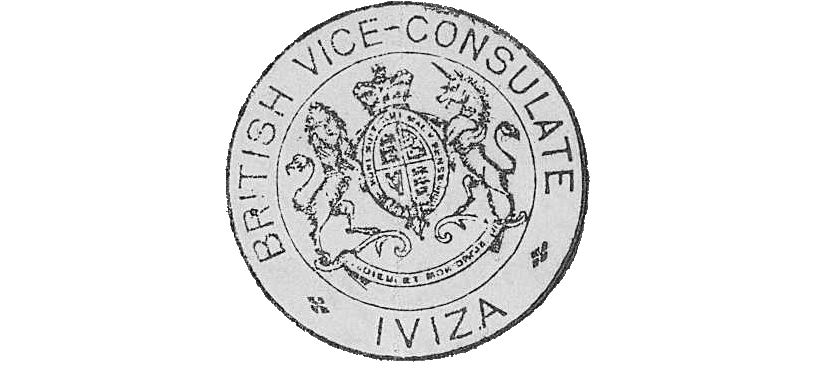
It wasn’t until May 8, 1899, that the inheritances were released by the administrator. It’s unknown how long it took for Alexander to forward all of it to Spain, as he first had to sell the real estate.
The John Novak factor
As with John Giblin’s estate, John Novak played a role in Farrague’s affairs. He had borrowed $1,000 from Farrague on January 18, 1893, secured by four waterfront lots (now owned by Stan Stearns) in the Millville plat of Gig Harbor. The note was due on January 18, 1894, along with ten percent interest, for a total of $1,100. Novak never repaid it. By January 18, 1897, with three more years of interest accrued, $1,464 was due on the note.
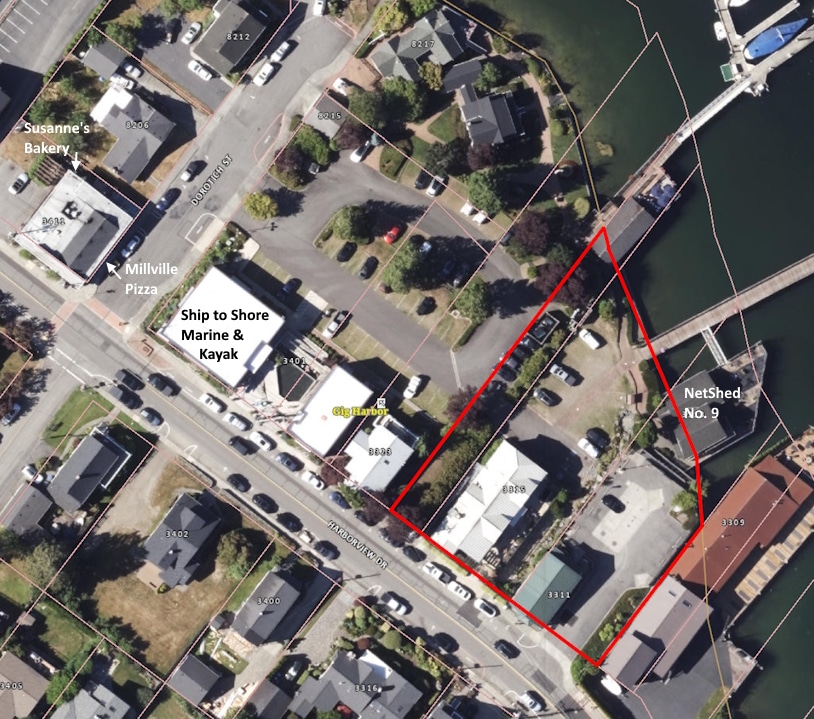
John Novak mortgaged the land outlined above to John Farrague, and never repaid the loan. Pierce County Assessor-Treasurer aerial base map.
When approached by the estate administrator Davis in the second half of 1897 about the three-years-overdue mortgage, Novak claimed he was broke. Davis advised the court that Novak had told him that “they are totally insolvent and have no other property of any kind other than household goods which are exempt from execution.”
Davis did not explain why he could not foreclose on the three mortgaged lots that Novak’s house did not occupy. He looked for other assets of Novak’s to attach, but came up empty. He left this note in the probate file:
I have made careful inquiry for other property than described above belonging to John Novick or his wife, and I fail to find any other than that covered by the above described mortgage, and I therefore conclude that a deficiency judgment could not be collected by process of law or otherwise.
What about the 60 acres Novak bought from John Giblin’s estate in 1892? Or the north 80 acres of Giblin’s homestead that he bought in 1890? Or his dozen unsold lots in Millville?
By May of 1897, Novak had sold all of it. Had Davis been able to move faster on Farrague’s estate, he might’ve been able to attach some of those other properties. But they were gone, and he could not. If Novak still had the proceeds of those sales, he wasn’t admitting to it.
Who bought the last of John Novak’s properties — 35 acres of the northeast corner of the former Giblin homestead, an unrelated parcel in Section 5, and twelve building lots in the Millville plat — in May, 1897, before they could be attached? Frank M. Novak, John’s brother.
Does less than $20 for each of the building lots in Millville sound like a sweetheart deal?
There is reason enough to believe that John Novak had put all his real estate into his brother’s name just to avoid having to repay the $1,000, plus accrued interest, to the Farrague estate. He may have had other debts he wanted to ditch as well.
Frank Novak’s sheltering of real estate for his brother John lasted for several years, at least. In the 19-teens, testifying under oath in Pierce County Superior Court concerning another matter, Nicholas Castelan said that in 1901 he bought Lot 5, Block 3 in Millville, one of the lots John had “sold” to his brother in 1897. He also said he bought it from John, not Frank, after negotiating the price with John. After pointing out to the illiterate Castelan that Frank Novak’s name was on the deed as the grantor, not John, the attorney questioning him asked, “Who is Frank Novak?”
Castelan answered, “I don’t know.”
Question: “Where is he?”
A: Maybe in the city.
Q: You did not buy the land from John?
A: I gave the money to him.
Q: You bought it from Frank?
A: I bought from John; John gave me that deed.
Q: Is this the only deed you ever had?
A: Yes, that is all.
Q: This is the deed you took when you bought the lot?
A: Yes, that is what he gave me.
John Novak had indeed effectively hidden his real estate assets from the reach of creditors by transferring them into his brother’s name. As the administrator of Farrague’s estate, Davis couldn’t attach them.
Having no alternative, Davis put the mortgage up for auction, but received no bids. He did finally sell the note at a huge discount. The buyer was the very same Frank M. Novak. He paid just $300 for it.
Gee, that doesn’t smell fishy at all, does it?
If it can be assumed that Frank Novak didn’t force his brother to pay him the full $1,464 balance due on the note, it becomes similar to Joseph Dorotich’s situation with the Giblin estate, in which case another wink, wink would be warranted.
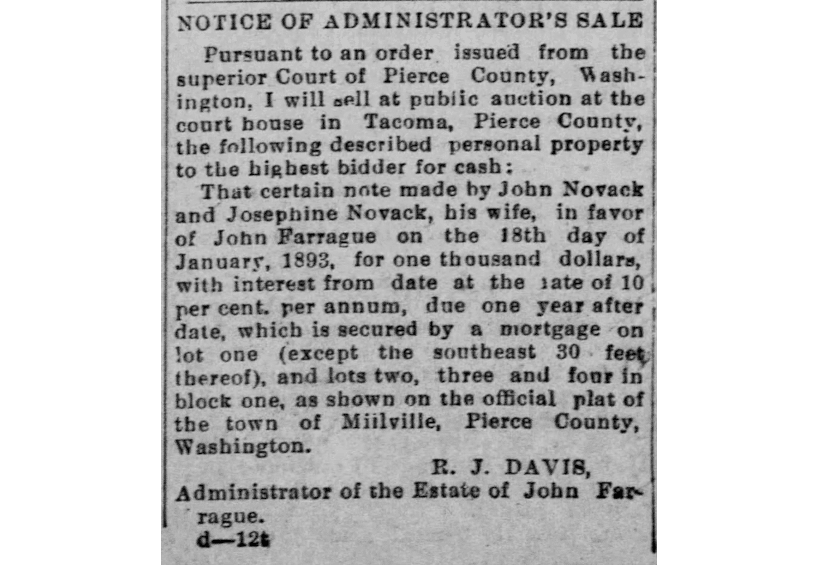
Never lost
In contrast to Joseph Oakes, and almost to John Giblin, John Farrague’s grave has not been lost. He was buried in the newly-opened Artondale Cemetery, and after 130 years, he’s still accounted for. His grave marker says Farragut rather than Farrague, but it’s him.
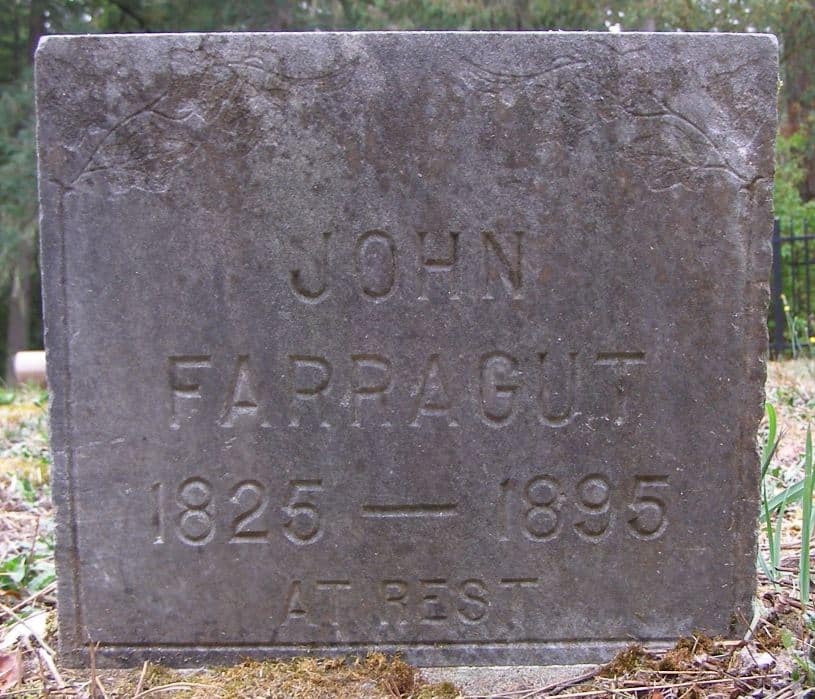
John Farrague’s headstone spells his name in the most common alternate form, Farragut. Photo by Greg Spadoni.
The final tally
There are unmarked graves on the Gig Harbor Peninsula, both inside and outside of local cemeteries. The Key Peninsula probably has a similar number, if not more, as it appears to have lagged the Gig Harbor area in creating public cemeteries.
When cemeteries were available, cost was a factor. Graveyard plots cost money, even in pioneer days. Fifteen dollars for John Giblin’s plot in what was supposed to be the Gig Harbor Cemetery in 1892 is a prime example. That equates to about $532 in 2025 dollars. Not an insurmountable fee today, but for subsistence farmers more than 100 years ago, cash was not easy to come by.
For both financial and personal reasons, some families buried their dead on their own property even after cemeteries were established, but only until the practice became illegal.
How many unmarked graves are there on the combined peninsulas? That’s impossible to know, although it’s probably safe to say the countryside is not littered with them. We’ve made note of one. There are, no doubt, many more, but it doesn’t seem likely there are hundreds.
But even if they number only in the dozens, there could still be one under your house. And I hope there is, for the more graves that are under other people’s houses, the less likely there’s one under mine.
Really old business
Simply because I thought it up, it’s fair to ask: What if John Novak’s $1,000 note to John Farrague was still valid? What if it was still attached to, and hanging over, the property today? How much would the current owner be on the hook for?
$290,960,772.36.
Ouch! (To put it mildly.)
The miracle of compound interest.
But that’s just through Jan. 18, 2025. Another $29 million in interest accrues next January, and we’re already three quarters of the way there.
New business
As we mentioned last time, this two-part column on local death and burial in the olden days was scheduled to coincide with the tours being held this month in the Artondale Cemetery. Sponsored by Liberty Henderson and the Harbor History Museum, they will take place on Oct. 12 and 19. If you would like to partake in a tour — and there’s probably no good reason for you not to — you can see the schedule and purchase tickets here.
Hmm … I wonder how many readers of this history column I’ll see on the tours? Any? Many? All of them?
Having finished my part of the research on the Select Eight, I can say with certainty that there will be some very interesting new information presented on the tours. Included will be two inspiring, direct quotes from the deceased themselves, showing the depth of their thinking, concern for their fellow citizens, and deep love for family. Being hearty pioneer stock meant far more than simple physical ruggedness.
Next time
In what should be a relief to us all, the next Gig Harbor Now and Then column, on Oct. 20, will not deal with dead bodies or unmarked graves … unless the Artondale Cemetery tours are reviewed. The last tours will take place one day before the next column is posted, so the timing will be right. And if some sort of supernatural occurrence happens during, or because of, the tours, it will have to be reported. So, maybe there will be more graveyard talk. Don’t know at this point. Makes me sorry I brought it up.
Whatever the primary subject turns out to be, the Oct. 20 column will likely include a short, sorry tale of failure on my part. Well, considering the previous paragraph, it would be more accurate to say another short, sorry tale of failure on my part. (As if I don’t display those here regularly.)
— Greg Spadoni, October 6, 2025
Greg Spadoni of Olalla has had more access to local history than most life-long residents. During 25 years in road construction working for the Spadoni Brothers, his first cousins, twice removed, he traveled to every corner of the Gig Harbor and Key Peninsulas, taking note of many abandoned buildings, overgrown farms, and roads that no longer had a destination. Through his current association with the Harbor History Museum in Gig Harbor as the unofficial Chief (and only) Assistant to Linda McCowen, the Museum’s primary photo archive volunteer, he regularly studies the area’s largest collection of visual history. Combined with the print history available at the museum and online, he has uncovered countless stories of long-forgotten local people and events.

